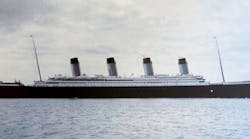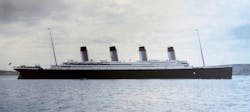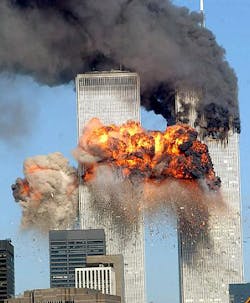Recall that on its maiden voyage over 102 years ago, most everyone hailed the Titanic as “unsinkable” due to its compartmentalized design, making it supposedly watertight (oh, the horrible irony of that.)
Yet the undoing of Titanic lay just below the surface of the sea some 400 miles from the coast of Newfoundland, Canada: an iceberg that ripped a long gash below the waterline of the ship, totally compromising its compartmentalized structure.
A purposeful lack of lifeboats (the ship’s owners didn’t want the decks to seem “too crowded”) and poorly organized evacuation compounded by ever-present human error left 1,500 of the great ship’s 2,200 passengers dead from drowning or exposure in the super-cold waters of North Atlantic.The fate of the Titanic is all the more tragic because of the aforementioned element of human error. If the ship had not been sailing along at top speed, perhaps the iceberg could have been seen in time. Hitting the iceberg dead-on, rather than being ripped down its side, might have preserved the watertight features within the ocean liner’s design.
More lifeboats would’ve made a difference, certainly, but many the ones launched that night were only half full. And the ship took two and half hours to sink: plenty of time to organize what could have been a more orderly and thorough evacuation, probably saving thousands more lives.
We’ll never know, of course. But echoes of the Titanic catastrophe can be felt today as we remember the terrorist attacks of Sept. 11 some 13 years ago – attacks by radical jihadists that left the World Trade Center a heap of rubble, part of the Pentagon destroyed, and thousands of Americans dead.
While our nation’s intelligence services got the lion’s share of the blame for not connecting known dots at the time (go here for more detailed analysis of that issue) the sheer simplicity of their attack methods – commandeering commercial jetliners by force and then deliberately crashing them into targets on the ground – took many by surprise.And while we’ve made steady improvements to our security protocols since the attacks (go here for some examples), the Titanic reference remains very apt: a huge, strong steel ship done in by a block of ice hidden by dark skies and opaque seas.
Henry Kissinger (at right) provided interesting perspective along similar lines in an article a few weeks ago in the Wall Street Journal; perspective that none-too-subtly connects the transportation industry to the larger issues of global disorder.
“The economic system has become global, while the political structure of the world remains based on the nation-state,” Kissinger wrote. “The international order thus faces a paradox: Its prosperity is dependent of the success of globalization, but the process produces a political reaction that often works counter to its aspirations.”
Add in the fiercely tribal, fanatical, and violent aims of groups such as Al-Qaeda, the Islamic State in Iraq and Syria (ISIS), and Boko Haram in Africa, just to name a few, and one sees why the cauldron of global risk continues to boil.
Remember, too, that the U.S. economy – and that of world – rests today on a web of electronic connections via the computers and the Internet that can be left in shambles relatively quickly by such things as power outages.
And thus here we all are, aboard a huge ocean vessel traveling dark and stormy seas. Some dangers we can see; others we cannot. It’s the reality of the global environment we must continue to navigate and thus why the lessons of Sept. 11 must remain close at hand.






